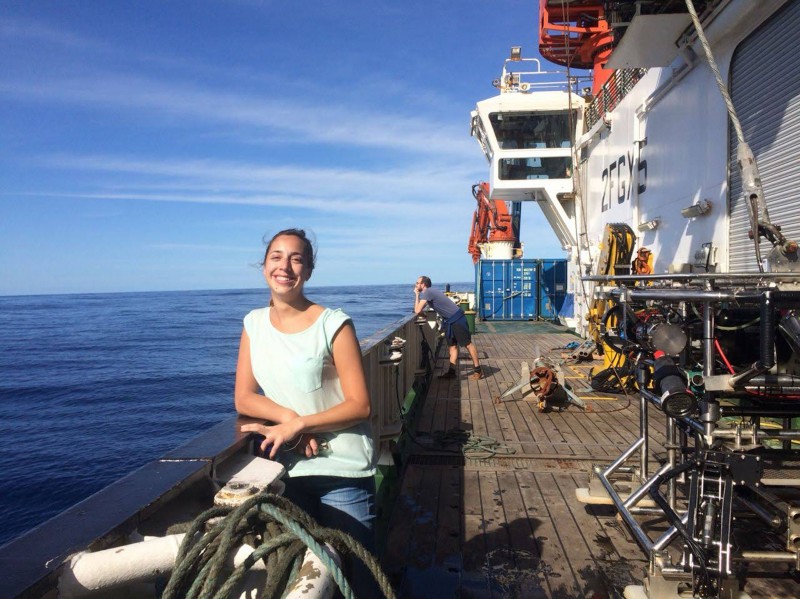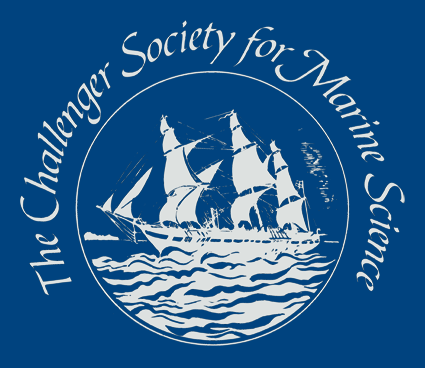Cruise to the Rio Grande Rise, South Atlantic aboard RRS Discovery
Berta Ramiro Sánchez
University of Edinburgh

On the 20th October 2018, 20 days after its original sailing date (due to problems at the dry dock and vessel refit), the Royal Research Ship (RRS) Discovery sailed from the Brazilian port of Santos to the Rio Grande Rise for three weeks to investigate cobalt-rich mineral deposits of interest to potential deep-sea mining. It was my first transatlantic research cruise and I was looking forward to the deep-sea discoveries and science equipment put in action.
The Rio Grande Rise (RGR) in the South Atlantic, 1400 km east of Brazil, is of interest for seafloor mineral deposits rich in iron, manganese, and other metals important to modern society. As part of the Marine E-Tech project (http://projects.noc.ac.uk/marine-e-tech/), the aim of the cruise was to improve the understanding of the processes controlling the formation and composition of deep-ocean mineral deposits and the biology that colonises them. I was part of the team of biologists studying the vulnerability of deep-sea fauna to disturbances that would arise if the sites were mined. The biological objectives were to characterize the diversity and structure of the benthic assemblages of the different habitats present in the area.
During the three days of transit to the site we prepared presentations to show our current research and plan the missions of the expedition. This gave me an opportunity to engage with the other biologists and geologists onboard with whom I would work closely during the sampling. Once on site and prior to any mission, the autonomous underwater vehicle Autosub6000 was launched from RRS Discovery to map the Rio Grande Rise in detail. After the area was mapped, high definition video cameras on the robotic underwater vehicle HyBIS were used to explore, sample and photograph features on the seafloor. It was my first time working with an ROV and it was amazing to watch live and explore the ocean floor. Dredges and gravity cores were also used to sample the seabed. Biologically, habitats were dominated by different organisms such as sponges, black corals and echinoderms, although these were sparsely distributed. In general we noticed low abundance and diversity probably caused by the low input of organic matter in this area. We collected and preserved samples from the dredge and HyBIS for DNA and taxonomic analysis.
In terms of working shifts we were very lucky. Every shift had the possibility to take part in every science operation, so I was able to observe and learn about the equipment and planning of each event. In general, the expedition was very successful and we only lost three days to poor weather when we had to run from an unseasonable cyclone. We returned back to the port of Santos on the 8th November 2018.
The experience was incredibly enjoyable and an eye-opener for future cruise opportunities. It was clear that preparation is key to any successful expedition. By working with more experienced sea-going biologists on the cruise, I appreciated all the pre-planning, preparation and equipment that is necessary to sample biological specimens; namely, for preliminary sample observation and classification, analysis, preservation, and reporting. Well-organized, successful teamwork made the experience memorably gratifying but, most of all, getting along with all the scientists and crew and meeting fantastic people made it one for the memory bank. Moreover, this opportunity has provided me with the chance to forge new science collaborations with other research disciplines and transatlantic institutes that would otherwise have not been possible. I am therefore really thankful to the Challenger Society and the project ATLAS for funding my trip and making this opportunity possible.
Latest News
Marine Data Management, Governance and the MEDIN toolset
The Marine Environmental Data and Information Network (MEDIN) and OceanWise are delighted to invite you to attend our popular free online training workshop: ‘Marine Data Management, Governance and the MEDIN toolset’ on the 19th – 23rd of May 2025.
Workshop on the contribution of UK Arctic Ocean science to the International Polar Year 32/33
12:00 11th June – 16:00 12th June 2025: NOC Southampton (In-person with online option): Registration deadline 16th May
REGISTER HERE
Pre-meeting questionnaire (open to all)
The purpose of this workshop is for the UK Ocean Science community to discuss and then draft a prospectus document outlining the priority Arctic research questions the community would like to address during the run up to, throughout and beyond the International Polar Year 32/33. Additionally, to identify what unique strengths and technologies the UK has to help fill these knowledge gaps.
The second day of the workshop will be dedicated to writing groups, one for each of the priority research questions identified - from both the pre-meeting questionnaire (HERE) and day one discussion. By the end of the meeting, each group will have produced draft text and sourced supporting figures for the prospectus.
Post meeting, the draft will be opened for comments and suggestions from everyone, regardless of whether they were able to attend the workshop or not. It will then be shared with UK funders (UKRI, FCDO, DSIT, ARIA) and potential international programmes with whom we would like to collaborate (e.g. Arctic 2050, Norway). It will form a basis from which wider integration with terrestrial, atmospheric and cryosphere communities can be built, e.g. at the UK Arctic Science Meeting in September in Northumbria.
To ensure balanced community and ECR representation, and to ensure that the size of the writing groups is efficient and effective, if the number of registrations from individual institutes becomes overwhelming, we may contact individuals or teams and ask that each institute selects a smaller number of individuals to attend in-person. Please wait for confirmation of in-person attendance before finalising travel arrangements.
The workshop will be open to hybrid attendance and contributions on both days.
Challenger Society Council Position Vacancy
The Challenger Society for Marine Science (CSMS) are pleased to announce an exciting opportunity to support the next generation of ocean scientists and innovators. CSMS are looking for a new Council member to fill the Student Travel Awards and Stepping Stones Portfolio. The successful applicant will administer the travel and research grants available for Early Career Researchers.
The role involves:
- Receiving applications for the two schemes and responding to applicant inquiries
- Soliciting and compiling input from the rest of the Council for assessing the applications
- Communicating with successful and unsuccessful applicants for the two schemes
- Working with the Honorary Treasurer on allocating funds to successful applicants
- Following up with award winners on their reporting requirements
- Attending Council meetings four times a year (in person or online) and contributing to discussions and decision making for CSMS
The usual term for Council members is three years.
For more information about the CSMS Council, please follow this link: https://www.challenger-society.org.uk/The_Council
For more information about our Early Career Researcher grants and awards, please follow this link:
https://www.challenger-society.org.uk/Stepping_Stones
and
https://www.challenger-society.org.uk/Travel_awards
If you are interested in applying or have any questions regarding the role, please contact kathen@bas.ac.uk
